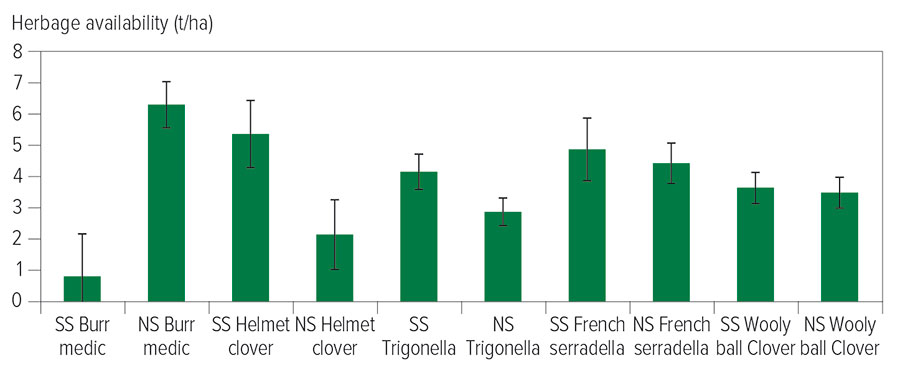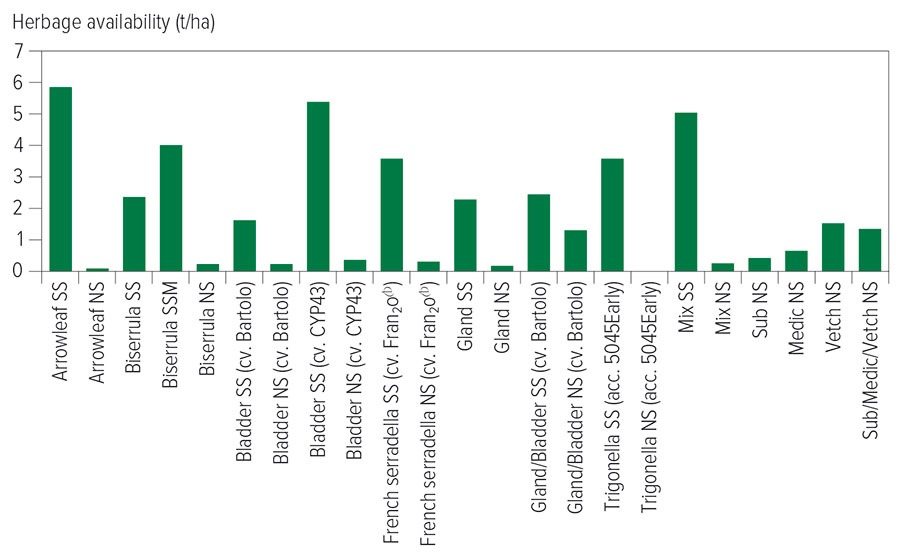Twin and summer sowing are two establishment techniques transforming pasture renovation in Australia’s low to medium-rainfall mixed-farming regions.
The innovative techniques were developed to establish pastures without interfering with the busy autumn and winter sowing period for crops. Traditionally, pasture paddocks are sown after the cropping program, often in June or July, but these pastures suffer from slow germination and poor early growth.
Pasture seed is often scarified to break down hard-seededness and ensure good establishment when sown in autumn or winter. However, the novel establishment techniques are suited to using unprocessed seeds or pods, which then have their dormancy broken down naturally over the summer and early autumn period.
These innovative methods, developed through the Dryland Legume Pasture Systems project, lower the cost and risk of failure of pasture establishment. Additionally, as these legumes are aerial seeders, the seed can be produced on-farm using conventional equipment, which further reduces its cost.
Summer sowing
For some legumes varieties, unscarified hard seeds or pods can be sown in February to March. After sowing, summer temperature and humidity fluctuations aid the breakdown of the hard seed to provide 30 to 50 per cent of seed ready for germination at the break of the season.
Summer sowing enables pastures to establish immediately after favourable rainfall in February or March, which provides a significant advantage over winter-sown pastures. Not all of the seed loses its dormancy; the remaining hard seeds are an ‘insurance policy’ against a false break. The seed dormancy breaks down during winter and spring and over the subsequent seasons.
Figures 1 and 2 show the performance of hard-seeded legumes at Canna, Western Australia, and Condobolin, New South Wales, using summer sowing or conventional sowing with scarified seed in late autumn. There are subtle differences in the summer and autumn conditions between these regions that influence the breakdown of hard-seededness and the choice of legume variety.
Figure 1: Herbage availability (t/ha) of pasture legumes summer-sown (SS) and normal-sown (NS) at Canna, WA, harvested 2 September 2020. Error bars represent standard error.

Source: MU and CSIRO
Studies in WA and southern NSW showed that the seed dormancy can be sufficiently broken down over a four-to-six-week period to produce about 150 seedlings per square metre following opening season rains. A 1.5 to tenfold increase in herbage production was achieved relative to subterranean clover sown conventionally in winter.
Figure 2: Herbage availability (t/ha) in mid-August 2021 for a range of annual legumes sown as unprocessed seed in summer (SS) or as scarified seed in late May (NS) at Condobolin, NSW. Four conventional species sown as scarified seed in late May are shown on the right-hand side. Note that the treatment ‘Biserrula SSM’ contained a mixture of 75 per cent unprocessed and 25 per cent scarified seed sown in summer; the treatment ‘Mix SS’ contained a mixture of all species used in summer sowing.

Source: NSW DPI
Twin sowing
Twin sowing entails sowing pod or unscarified seed with high levels of hard-seededness (more than 90 per cent) together with grain crops in May/June the year prior to a pasture phase. This reduces establishment costs, as the pasture legumes and crop are sown in one operation.
With this method of sowing, the legume seed is lightly buried in the soil for an entire cropping season. It does not germinate in the crop due to its dormancy, but this softens over the summer following harvest of the winter grain crop and is ready to germinate at the break of the next season in the autumn.
While twin sowing has been successful, its efficiency in terms of emergence of seedlings per kilogram of seed sown is generally lower than for summer sowing. However, twin sowing can be a more effective way to establish pasture than conventional cover cropping.
Cover cropping
Cover cropping involves sowing scarified seed at a reduced rate with the previous crop, so that the pasture germinates and grows under the crop. In many cases the pasture has difficulty competing for light and moisture with the crop, causing poor growth and seed production. Reducing the crop density can help address this. Cover cropping also reduces in-crop herbicide flexibility.
Twin sowing has many advantages over cover cropping. It removes the need to scarify the legume seeds and the competition with the crop, as the year within crop simply acts as a period for seed softening. There is no requirement to cut back the sowing rate of the final crop in the rotation and does not reduce herbicide options.
Considerations
- Paddock preparation for summer and twin sowing
Good weed management prior to sowing is paramount. Excessive weed competition is the leading cause of pasture establishment failure with the novel techniques. A minimum of two, but preferably three, years of stringent weed management leading into pasture sowing is recommended.
Check for potential herbicide carry-over prior to sowing a new pasture. Factors that can influence herbicide breakdown and hence plant-back requirements include time elapsed since application, rainfall received since application, soil moisture conditions, soil pH, soil texture and the application rate. Make sure to abide by all label requirements and, if in any doubt, seek advice.
- Sowing rate and depth
Ensure the pasture seed is sown at one to two centimetres. Deeper placement will reduce emergence and is a common cause of establishment failure, especially with twin sowing. For twin sowing, some growers have successfully dropped the seed or pods on the soil surface in front of the cereal sowing tynes and relied upon soil scatter at seeding to give sufficient burial.
- Inoculants
It is critical when sowing any legume that an inoculant is used containing the correct rhizobia for that particular legume species, especially if the legume has not been grown in the paddock for the past three or four years. Granular inoculants are convenient to use and can provide superior rhizobial survival and nodulation over peat when sowing into dry soil. If using a peat inoculant, make sure treated seed is sown within 12 hours and kept out of direct sunlight.
- Management in the establishment year
The main goal in the pasture establishment year is to achieve adequate growth and seed-set for future regenerations. Careful monitoring is required for signs of insect pests such as budworm, red-legged earth mite and aphids.
Where a high weed population occurs, it is important to start management early while the weeds are small. The tolerances of hard-seeded legumes to herbicides can vary considerably and it is important to seek advice on registered options.
In some situations, other options might be appropriate. For example, biserrula is somewhat unpalatable to grazing animals – which prefer annual ryegrass, wild radish and capeweed – so grazing will often reduce weed numbers. Weed wipers have also proven effective in killing weeds that sit above the pasture canopy later in the growing season, or where grazing has been used to reduce pasture height below that of the target weeds.
This research was part of the national Dryland Legume Pasture Systems project supported by the Australian Government Department of Agriculture, Water and Environment (DAWE) Rural R&D for Profit program and the Grains Research & Development Corporation, Meat & Livestock Australia and Australian Wool Innovation.
More information: Dr Ron Yates, ronald.yates@dpird.wa.gov.au; Robert Harrison, robert.harrison@csiro.au; Dr Belinda Hackney, belinda.hackney@dpi.nsw.gov.au

























































